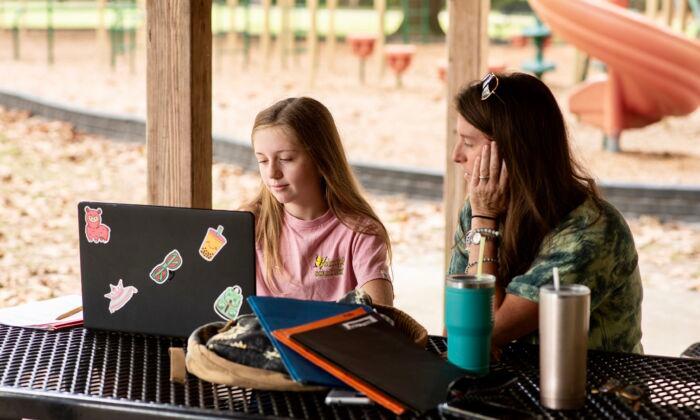Some school districts grappling with how to help students better manage stress are adding “calming rooms,” where children can stretch, do arts and crafts, listen to soothing music, and more.
The trend is a response to multiple studies showing an uptick in anxiety and depression among teens and young adults, apparently triggered by pandemic lockdowns, researchers have said.
But some parents and school officials worry that encouraging the use of calming rooms robs children of the opportunity to develop coping skills that will serve them well in adult life.
School officials in Alachua, Florida opened a calming room at Santa Fe High School on Nov. 1. Beanbag chairs invite students to lounge and try activities said to relieve stress, such as coloring or working with Rubik’s Cubes and other puzzles.

The space also is designed to help students who lack strong social skills due to pandemic lockdowns, Jamarr Akins, spokesman for Alachua County Public Schools, told The Epoch Times.
“The room is a waiting area for when the school counselor is not immediately available,” Akins said. “It allows the student to gather their thoughts and calm down from whatever is stressing them at the time.”
A school counselor closely monitors the room, he said.
“Students who are usually very guarded with their feelings are now seeking counseling,” Akins said.
The county plans to open more calming rooms for elementary and middle school students, said Capt. Kaley Behl, spokeswoman for the Alachua County Sheriff’s Office.
It’s “a safe and relaxing space for students during the day who need to take a few minutes to calm themselves when they are feeling overwhelmed,” Behl told The Epoch Times. ”I think students today have a stressful and hectic environment, and having this room as a resource should prove to be a coping mechanism and a resource to use when necessary.”
Alachua County has joined a growing number of schools across the United States that are incorporating calming rooms.
Some rooms are outfitted so that students can draw on whiteboards with markers, color with crayons, or squeeze “stress balls” to help relieve anxiety.
The aim is to provide activities that calm students and allow them to concentrate on something other than what’s bothering them.

The calming room at Garden Grove Unified School District in California sports a more spa-like atmosphere with plants, plush carpets, and pillows in shades of blue. There are yoga mats for use in stretching, and supplies for creating arts and crafts. Soft music plays in the background.
The district opened 10 calming rooms in February. More are planned through a partnership with the county Department of Education and Children’s Health of Orange County.
Marcie Griffith, principal at John Murdy Elementary in Garden Grove, told reporters that the demand for counseling among students increased when they introduced the rooms to the community, reported FOX 11 in Los Angeles.
“The stresses at home are high for many of our kids,” Griffith said, during a press tour of the facility. “Stress is a normal part of life, and sometimes everybody needs a little extra bit of help in dealing with that. This is a special room to help us find our peace.”
Because of the lockdowns, many children lack social skills, Griffith said. But they’re also overwhelmed in class, which brings high anxiety, she added.
Visits to the room have slowed, indicating that children may be learning better coping skills with help from school counselors, Griffith said.
“We want kids to be able to regulate their own emotions,” she said. “When they’re in here, they know they don’t have to talk to us, but feel, ‘There’s a safe person here that I can just sit here with and I can get through this.’”
More than a third of Americans ages 13–56 said the pandemic was a significant source of stress, according to a study by the National Opinion Research Center (NORC) at the University of Chicago, the Associated Press, and MTV Entertainment Group.
Respondents reported that the pandemic made life harder, especially friendships and dating, researchers said. And members of Generation Z, age 13–24, expressed that the COVID-19 crisis has made it harder to achieve career goals.
But calming rooms may hamper, rather than strengthen, children’s coping skills, some parents told The Epoch Times.
“This is just creating dependency and not getting to the root of the problem,” said Bridget Ziegler, a member of the Sarasota County School Board. She said she wouldn’t support adding calming rooms in the school district she serves.
Tanya Parus, president of the Sarasota County Moms for America, is concerned calming rooms encourage weakness, rather than strength.
She worries about the effects of the “coddling of children,“ not allowing them to “deal with life’s problems in an organic way,” she told The Epoch Times.
“What kind of military can we hope to have in the future?” she asked. “You’re not giving them life skills.”
Being alone with a counselor in a room is concerning, as parents won’t know what their children are being told by, Parus said.
And providing calming rooms will bring on a sense of entitlement that will “bring the wrong kind of support” into children’s lives, she said.
She worries that be encouraging children to seek counseling at school, they won’t confide in parents about their problems.
And they may receive advice that goes against values parents would teach in the home, she said.
Parus said that the “tough love” she was shown as a child and an adolescent has benefited her in her adult life. Instead of running to a calming room, children should be taught to face fears and conflicts head-on, she said.
“At that age you don’t have the greatest relationship with your parents, at times,” she said. “I had my mom and dad, both on top of me saying, ‘Guess what. This is life. Make better choices.'”




